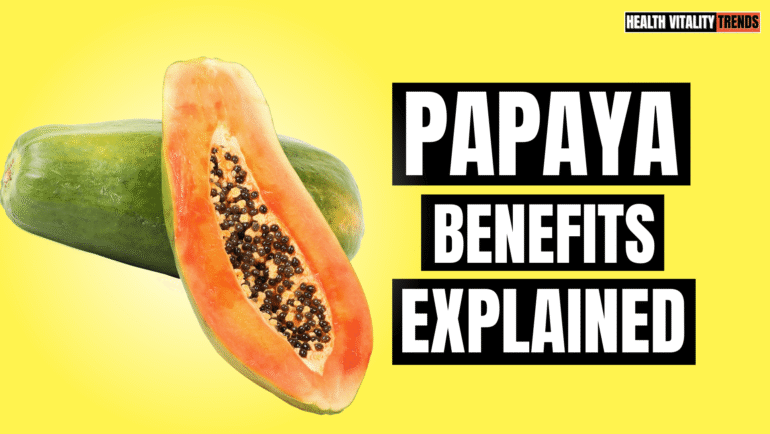
PASSION FRUIT: Tropical Flavor, Mood Lifter & Vitamin Rich
Passion fruit is a tropical fruit known for its unique aroma, tangy-sweet flavor, and impressive nutrient profile.
Small but powerful, it’s loaded with fiber, vitamin C, and antioxidants that support digestion, immunity, and heart health.
Its exotic appearance and refreshing taste make it popular in juices, desserts, and smoothies worldwide.
Let’s explore what makes passion fruit special, its nutrition facts, health benefits, and the best ways to enjoy it.
What is Passion Fruit?
Passion fruit (Passiflora edulis)[1] is a round fruit native to South America, now grown in tropical and subtropical regions worldwide, including Brazil, India, and Australia.
It has a tough outer rind that ranges from purple to yellow, while the inside contains jelly-like pulp with edible black seeds.
Apart from its nutritional value, passion fruit is linked to the “passion flower,” which has been traditionally used for calming effects in herbal medicine.

What Does Passion Fruit Taste Like?
Passion fruit has a distinctive flavor that’s both sweet and tart. The pulp is juicy and fragrant, often described as tropical, citrusy, and floral. The seeds add a crunchy texture.
Yellow varieties are more acidic, while purple varieties are sweeter. Its bold taste makes it perfect for juices, cocktails, jams, and desserts.
Passion Fruit Nutrition Facts
Here’s the nutrition profile of 100 grams of raw passion fruit (USDA data)[2]:
| Nutrient | Amount |
|---|---|
| Calories | 97 kcal |
| Carbohydrates | 23 g |
| Protein | 2.2 g |
| Fat | 0.4 g |
| Fiber | 10 g |
| Vitamin C | 30 mg (33% DV) |
| Vitamin A | 64 µg (7% DV) |
| Iron | 1.6 mg (9% DV) |
| Potassium | 348 mg |
| Magnesium | 29 mg |
Explanation:
Passion fruit is rich in dietary fiber, which supports digestive health. It provides a high dose of vitamin C for immune support and contains plant compounds like polyphenols and carotenoids that have antioxidant and anti-inflammatory effects. Its mineral content, especially potassium and magnesium, helps regulate blood pressure and heart health.
Health Benefits of Passion Fruit
1. Boosts Immunity
High in vitamin C and antioxidants, passion fruit helps protect the body from infections and supports faster recovery.[3]
2. Supports Digestive Health
With 10 grams of fiber per 100 g, passion fruit promotes bowel regularity and feeds healthy gut bacteria (USDA).[2] [3]
3. Improves Heart Health
Potassium and fiber contribute to lower blood pressure and cholesterol levels, reducing the risk of heart disease.[3]
4. Helps Manage Blood Sugar
Passion fruit has a low glycemic index and soluble fiber, which may help regulate blood sugar levels, making it beneficial for diabetics.[3]
5. Promotes Relaxation
Passion fruit contains bioactive compounds from the passion flower family, which have mild sedative properties and may improve sleep quality.[3]
6. Supports Skin Health
Antioxidants and vitamin A in passion fruit protect the skin from free radical damage and promote a healthy glow.[3]
How to Eat Passion Fruit
- Cut the fruit in half and scoop out the pulp with a spoon.
- Add pulp to smoothies, juices, or cocktails for a tropical flavor.
- Mix with yogurt, oatmeal, or chia pudding for a nutritious snack.
- Use in desserts like tarts, sorbets, or cheesecakes.
- Strain seeds to make passion fruit syrup or salad dressing.
Fun Fact: In Brazil, passion fruit juice is a common refreshing drink and is often served as a natural calming beverage before bedtime.

How to Store Passion Fruit to Keep Them Fresh
- Room Temperature: Store whole fruit until the skin becomes wrinkled, indicating ripeness.
- Refrigeration: Keep ripe passion fruits in the refrigerator for up to 5 days.
- Freezing: Scoop out the pulp and freeze in ice cube trays for smoothies, sauces, or desserts (lasts up to 3 months).
Possible Side Effects and Precautions
Side Effects
- Allergic Reactions – Rare but possible, especially in people allergic to latex.
- Digestive Issues – Overeating may cause bloating or diarrhea due to its high fiber content.
- Low Blood Pressure – Excess intake may lower blood pressure too much in people already on antihypertensive medication.
Precautions
- Diabetics should eat in moderation despite its low glycemic index, as it contains natural sugars.
- People with latex allergy should be cautious, as cross-reactivity may occur.
- Pregnant and breastfeeding women can safely eat passion fruit in moderation, but concentrated extracts should be avoided without medical advice.
- Children should consume small portions to avoid choking on seeds.
Fruits Similar to Passion Fruit
- Granadilla – A sweeter relative with a similar jelly-like pulp.
- Kiwi – Tangy flavor and edible seeds with a similar texture.
- Mango – Sweet tropical fruit rich in vitamins and antioxidants.
- Guava – Fragrant fruit with edible seeds and a nutrient-rich profile.
Common FAQs About Passion Fruit
1. Is passion fruit good for weight loss?
Yes, its high fiber content helps increase satiety, reducing overeating.
2. Can you eat the seeds of passion fruit?
Yes, the seeds are edible, crunchy, and provide healthy fats and antioxidants.
3. How many passion fruits can I eat per day?
1–2 medium passion fruits are sufficient for most people to enjoy its benefits without overdoing sugar or fiber intake.
4. Is passion fruit safe for diabetics?
Yes, in moderation. Its low glycemic index makes it a better fruit choice for blood sugar control compared to many other tropical fruits.
Conclusion
Passion fruit is a tropical gem packed with fiber, vitamin C, and powerful antioxidants that benefit digestion, immunity, and heart health. Its tangy-sweet flavor makes it versatile in juices, desserts, and smoothies. Eating passion fruit regularly can support both short-term energy and long-term wellness, making it a delicious and nutritious addition to a balanced diet.
References
- [1] https://en.wikipedia.org/wiki/Passiflora_edulis
- [2] https://www.nutritionix.com/i/usda/passion-fruit-granadilla-purple-raw-1-fruit-without-refuse/513fceb575b8dbbc210010f0
- [3] https://www.researchgate.net/publication/388451379_Nutritional_Values_and_Current_Research_on_Passion_Fruit_Passiflora_Edulis








